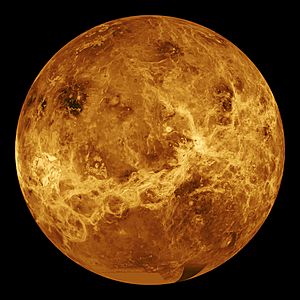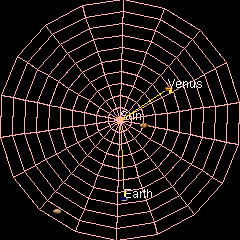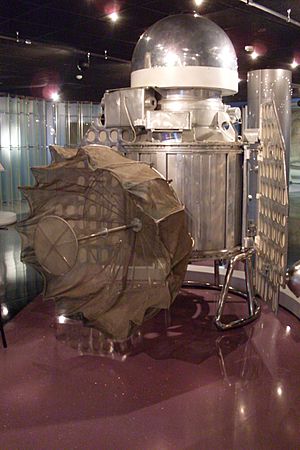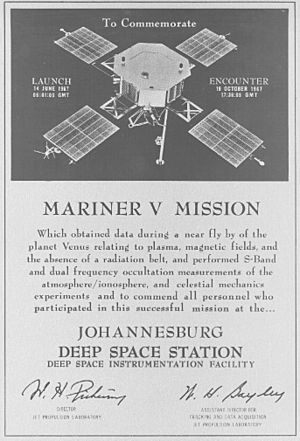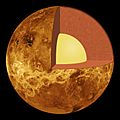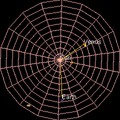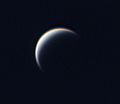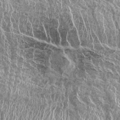Venus facts for kids
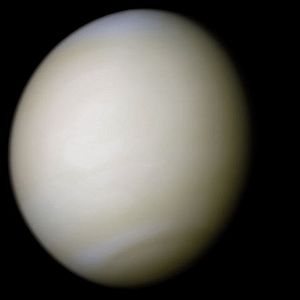
A real-colour image taken by Mariner 10 processed from two filters, the surface is obscured by thick sulfuric acid clouds
|
|||||||||||||||||
| Designations | |||||||||||||||||
|---|---|---|---|---|---|---|---|---|---|---|---|---|---|---|---|---|---|
| Adjectives | Venusian or (rarely) Cytherean, Venerean | ||||||||||||||||
| Orbital characteristics | |||||||||||||||||
| Known satellites | None | ||||||||||||||||
| Physical characteristics | |||||||||||||||||
|
Mean radius
|
|
||||||||||||||||
|
|||||||||||||||||
| Volume |
|
||||||||||||||||
| Mass |
|
||||||||||||||||
|
Mean density
|
5.243 g/cm3 | ||||||||||||||||
|
|||||||||||||||||
|
|||||||||||||||||
| Atmosphere | |||||||||||||||||
|
Surface pressure
|
92 bar (9.2 MPa) | ||||||||||||||||
| Composition by volume |
|
||||||||||||||||
Venus is the second planet from the Sun. It's special because its day is longer than its year! A year on Venus lasts about 225 Earth days. But a single day on Venus takes about 243 Earth days. This means the Sun rises only twice during each Venusian year.
Venus is a terrestrial planet. This means it has a solid, rocky surface, just like Earth and Mars. People have known about Venus for thousands of years. The ancient Romans named it after their goddess of love, Venus. It's the brightest object in the night sky, besides the Moon. Sometimes it's called the morning star or evening star. This is because you can easily see it just before sunrise or just after sunset. Venus gets closer to Earth than any other planet.
Venus is often called Earth's sister planet. This is because they are similar in size and gravity. But in many other ways, they are very different. Venus's atmosphere is mostly carbon dioxide. It also has thick clouds made of sulfuric acid. Sulfuric acid is a chemical that is very poisonous to humans.
The thick atmosphere makes it hard to see the surface. For a long time, people wondered if anything could live there. The air pressure on Venus's surface is 92 times stronger than on Earth. Imagine being at the bottom of a deep ocean! Venus has no moons. It also spins very slowly. And it spins in the opposite direction compared to most other planets.
Contents
What is Venus Like?
Venus is a rocky planet, much like Earth. But it is far hotter than Earth. All the carbon dioxide in its atmosphere acts like a thick blanket. This blanket traps heat from the Sun. This effect is called the greenhouse effect, and it's very strong on Venus.
Because of this, Venus has the hottest surface of any planet in our Solar System. The average temperature is about 480 °C (896.0 °F). This is hot enough to melt metals like lead or zinc!
Venusian Geography
Venus has no oceans because it is too hot for water to exist as a liquid. Its surface is a dry desert. Because of the thick clouds, we can only map the surface using radar. About 80% of Venus is smooth, rocky plains. These plains are mostly made of a rock called basalt.
There are two higher areas that are like continents. They make up the northern and southern parts of the planet. The northern one is called Ishtar Terra. The southern one is called Aphrodite Terra. They are named after ancient goddesses of love.
The surface of Venus looks like it has been shaped by volcanic activity. Venus has many volcanoes. Scientists think the surface of Venus is between 300 and 600 million years old.
Venus's Atmosphere
Venus's atmosphere is mostly carbon dioxide and nitrogen gas. It has thick clouds of sulphuric acid. Because the atmosphere is so dense, the pressure is very high. It's 92 times the pressure on Earth. This is enough to crush many things.
You cannot see the planet's surface from space. This is because the thick cloud layer reflects 60% of the sunlight that hits it. Scientists can only see the surface by using special infrared and ultraviolet cameras and radar.
Scientists believe that billions of years ago, Venus's atmosphere might have been like Earth's. There might have been a lot of water on its surface. But over time, the water evaporated. This caused a strong greenhouse effect and filled the atmosphere with greenhouse gases.
Magnetic Field Around Venus
In 1967, the Venera 4 spacecraft found that Venus's magnetic field is much weaker than Earth's. This magnetic field is created by an interaction between the ionosphere and the solar wind. Venus's magnetic field is not strong enough to protect its atmosphere from harmful cosmic rays.
Transit of Venus
Sometimes, Venus can be seen passing directly between the Sun and Earth. When this happens, Venus looks like a small black dot moving across the Sun. These events are called "transits." Transits of Venus happen in pairs, eight years apart. After a pair, it's usually more than a hundred years until the next pair.
How Venus Orbits and Rotates
Venus orbits the Sun at an average distance of about 108 million kilometers (67 million miles). It takes about 224.7 Earth days to complete one orbit. Venus spins very slowly. In fact, a single day on Venus is longer than its year!
Exploring Venus
The first robotic space probe mission to Venus was the Soviet Venera program in 1961. This was the first mission to any planet! The United States' first successful mission was Mariner 2 on December 14, 1962. It was the world's first successful interplanetary mission. It flew about 34,833 kilometers (21,644 miles) above Venus and collected data about its atmosphere.
On October 18, 1967, the Soviet Venera 4 successfully entered Venus's atmosphere. It sent back scientific information. Venera 4 showed that the surface temperature was much hotter than expected, almost 500 °C (932 °F). It also found that the atmosphere was 95% carbon dioxide (CO2). The atmosphere was also much denser than expected. Data from Venera 4 and Mariner 5 were even studied together by Soviet and American scientists. This was an early example of space cooperation.
Venera 7, the first space probe to land on Venus, was destroyed by the harsh conditions after only 23 minutes. In 1974, Mariner 10 flew past Venus on its way to Mercury. It took ultraviolet pictures of the clouds, showing extremely fast winds in Venus's atmosphere.
In 1975, the Soviet Venera 9 and 10 landers sent the first black and white images from Venus's surface. In 1982, the Soviet Venera 13 and 14 landers sent the first color images.
NASA also gathered more data in 1978 with the Pioneer Venus project. This project included two missions: Pioneer Venus Orbiter and Pioneer Venus Multiprobe. The successful Soviet Venera program ended in October 1983. Venera 15 and 16 were put into orbit to map 25% of Venus's surface in detail.
Several other spacecraft flew past Venus in the 1980s and 1990s. These missions helped us understand Venus even more. They included Vega 1 (1985), Vega 2 (1985), Galileo (1990), Magellan (1994), Cassini–Huygens (1998), and MESSENGER (2006).
Then, the Venus Express from the European Space Agency (ESA) entered orbit around Venus in April 2006. It had seven scientific tools. Venus Express gave us a long-term look at Venus's atmosphere like never before. ESA finished that mission in December 2014.
As of 2016, Japan's Akatsuki is in a stretched-out orbit around Venus since December 7, 2015. Also, Roscosmos, NASA, and India's ISRO are studying new mission ideas for Venus.
In 2016, the NASA Innovative Advanced Concepts program looked into a rover called the Automaton Rover for Extreme Environments. This rover is designed to survive for a long time in Venus's harsh conditions. It would be controlled by a mechanical computer and powered by wind.
Related pages
Images for kids
-
Size comparison with Earth.
-
Impact craters on the surface of Venus (false-colour image from radar data).
-
Global view of Venus in ultraviolet light done by Mariner 10.
See also
 In Spanish: Venus (planeta) para niños
In Spanish: Venus (planeta) para niños


